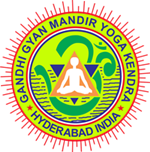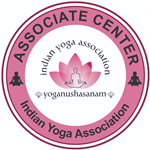As in the previous asanas, these standing asanas are also useful for everyone, particularly for youth. Every asan may be repeated 5 to 10 times.
- 1. Vayuyanasan
- 2. Rocket asan
- 3. Hasta Padangushthasan
- 4. Konasan
- 5. Trikonasan
- 6. Dhruvasan
- 7. Vaatayanasan
- 8. Garudasan
- 9. Shirshasan
- 10. Taadasan
1. Vayuyanasan:
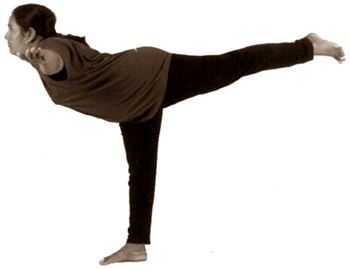
Vayuyan means an aeroplane. The body in this asan is postured like the shape of an aeroplane.
Procedure:
Stand up stretching both the hands side wise. Bending forward from the waist, slowly raise the left leg backward straight
without bending the knee. The body should be in the shape of an aeroplane, standing on right foot.
Stay for some time comfortably maintaining the balance, breathing slowly.
Similarly perform it changing the leg.
Awareness:
Balance of the body
Advantages:
This asan helps in maintaining the balance of the body and mind. Concentration is also developed. Body is felt light.
“Vayuyanasan makes the body feel like flying in the sky”
2. Rocket asan:
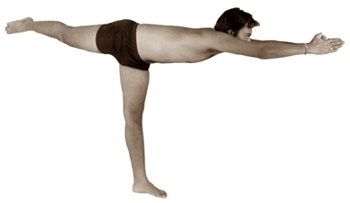
The body takes the shape of a rocket in this asan.
Procedure:
Stand erect with hands stretched upwards and palms together to form namaskar. Now as in the Vayuyanasan, bend the body forward, stretching one leg backward straight. The body should be kept in the shape of a rocket.
After few seconds, perform similarly changing the legs.
Awareness:
Vertical stretch in the body
Advantages:
This asan helps in maintaining the balances of the body and mind. The nerves in the legs re strengthened.
“Rocket asan strengthens the nerves”
3. Hasta Padangushthasan:
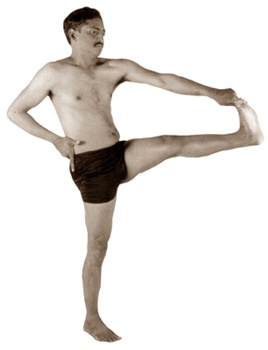
Toe is held by the hand in this asan.
Procedure:
Standing erect , raise the right leg stretching straight. Holding the toes of the right leg with both the hands, adjust the body balance to stand on one leg. After some time, change the leg. Breath should be normal.
Note: At the beginning this should be practiced taking the support of a wall to maintain the balance. After getting control on body balance, the support of the wall may be withdrawn and practiced.
Awareness:
Physical balance
Advantages:
It reduces tiredness, strengthens all the parts of the body, activeness is increased. Legs are strengthened. Navel is stronger in its place, so that it does not dislocate.
“Hasta Padangushthasan retains the balance of the body and mind”
4. Konasan:
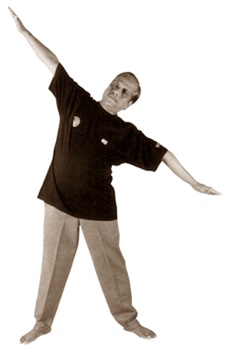
Kon means angle. The body is postured in different angles in this asan.
Procedure:
Stretching the legs apart, keep both the hands stretched sidewise straight. Breathing out, bend towards left side downwards, raising the right hand in the same proportion. After some time, breathing in, come into central position. Repeat the same in the right side.
Awareness:
Sides of waist
Advantages:
Muscles and nerves of arms, legs and waist are stimulated. Tiredness is reduced.
“Konasan stimulates the body”
5. Trikonasan:
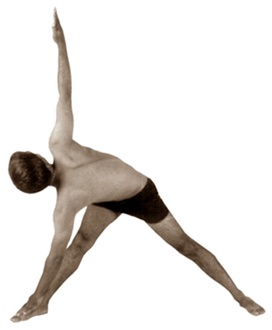
Trikon means triangle. The body takes the shape of a triangle in this asan.
Procedure:
1. Stretch both the legs apart and also stretching both the hands straight sidewise. Bending at the waist let the left hand fingers touch the right foot breathing out. After few seconds, breathing in, come up to the central standing position. Repeat the same on the other side also. Knees should not be bent.
2. Being in the downwards-bent posture as above, touch the right and left feet with fingers of alternate hands in quick succession one after the other.
Awareness:
Waist
Advantages:
Shanks, thighs, waist and backbone are strengthened.
“Trikonasan stimulates the waist”
6. Dhruvasan:
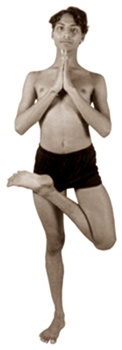
Bhakta Dhruv meditated in this asan, so it has got its name.
Procedure:
Standing straight, stretch both the hands sidewise. Bend the right leg and place sole of the right foot on the left thigh. The entire body rests on left foot. Later bring both the hands near the chest and join in namaskar mudra. After some time bring the right leg down. Repeat the exercise with the change of leg. Breathe normally.
Awareness:
The center of the eyebrows / the Lotus heart (center of chest)
Advantages:
Laziness vanishes, concentration improves. It is a very useful to jap (chanting), tap (penance) and Dhyan (meditation).
“Dhruvasan helps in concentrating the mind”
7. Vaatayanasan:
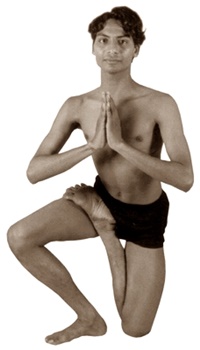
Saint Vaatayan used to meditate in this asan, so it got its name.
Procedure:
Standing straight, lift the right foot as in Dhruvasan. Place the right sole on the left thigh. Both the hands are joined into namaskar mudra before the chest. Bending the left knee forward, place the right knee near the left heel. Hold the body in this posture for some time. Breathe normally. After some time come to normal position. Later repeat the same on other side also.
Awareness:
The urinary organ
Advantages:
It helps in keeping up the celibacy. Diabetes, excess urination, semen discharge, ill dreams…..sciatic pains and hernia are cured. Knees, waist and the backbone are strengthened.
“Vaatayanasan helps in protecting the celibacy”
8. Garudasan:

The body takes the shape of a Garud (eagle) bird in this asan.
Procedure:
Standing up, cross both the hands and legs.
Keeping the right leg on the floor, lift the left leg a little up, and turn around across the right knee. The foot of the left leg is placed on the right shank. Then bend the right hand at the elbow and raise up. Turn the left hand round across the right elbow placing the left palm on the right palm in the namaskar mudra. After some time bring the body to normal standing position. Later, repeat it changing the legs and hands on the other side.
Note: In the initial stage crossed leg toes may be rested on the floor.
Awareness:
Balance of body and mind
Advantages:
Hernia, waist pain, paralysis, and sciatic pains are relieved. Nerves are stimulated and become more active.
“Garudasan strengthens the nerves of hands and legs”
9. Shirshasan:

Entire body stands on the head (=Shir), so it is called Shirshasan. It is deemed to be king of asanas. This is a difficult asan.
Procedure:
Sitting in Vajrasan, bend forward as in Shashankasan. Interlocking both the palms, resting the entire weight of the body on the hands, place the head on the floor. The center of the head does not touch the floor, only forehead touches the floor. Raise the knees, later both the legs also upwards. Shanks, thighs, waist and back are straight. Eyes should be closed. The whole body stands on the head, yet the weight on the head is very little but it is more on the hands. Remaining in this stage for some time, bring the body, slowly down to Shashankasan with great care and then to normal position of Vajrasan.
Breathing is normal.
Initially perform Shirshasan for half a minute only for about 2 to 3 weeks, later it is extended to two minutes.
After posturing Shirshasan, Taadasan and Shanti asan should be postured compulsorily.
Note: A thick cloth should be rounded under the head.
Awareness:
Whole body – particularly inside the head
Advantages:
All the glands in the body are energized. Blood circulation is thoroughly regulated in the brain and whole nervous system. Lungs and heart function well. All the systems of the body become healthy. Grey hair turn black. The sight is well maintained. Memory power increases. Diabetes and piles are cured. The complexion of the body brightens. Few opine that it cures the diseases of uterus.
Prohibition:
People suffering from acute eyes, ear and nose diseases, high blood pressure, heart diseases, neck pain and spondylitis are warned not to attempt this asan. People who had head injury and weak also should not attempt this asan. Few Yoga experts prevent women to attempt this asan.
Advice:
In the initial stage it should be postured taking the support of a wall, under the guidance of Yoga expert. It need not be postured for more than two minutes.
“Shirshasan blesses a new life”
10. Taadasan:

Taad means palm tree. The body is in the shape of a palm tree in this asan.
Procedure:
Standing straight, stretch both the hands upward straight spreading the palms, so that both the thumbs are joined. Raise the heels making the body stand only on toes. The whole body is stretched up. After standing for a while in the stretched position, come down and relax. Breathe normally.
After stretching 2 to 3 times, being in the Taadasan, without bending the knees, walk forward on toes a few small steps. During these steps heels don’t touch the floor.
Awareness:
Upwards stretch in the whole body
Advantages:
It strengthens the back bone and heart. Chest expands well and the lungs become active. Unwanted fat of the body is reduced. All the nerves of the body are stimulated and energized. The height of the children below 15 years is increased.
Note: Taadasan is to be practiced, compulsorily after posturing Shirshasan.
“Taadasan energizes all the nerves of the body”
![]()
Apart from the above mentioned, there are numerous asanas, which can be performed in standing position.
All the asanas practiced in the standing position make the body supple and more active. After practicing these asans, the practitioner must rest first in Nispand bhavasan and then in Shanti asan for more benefits.
![]()
